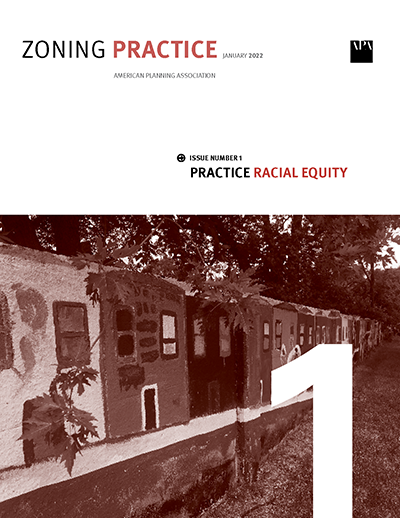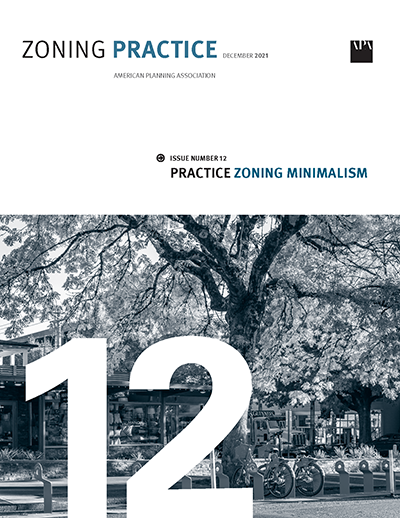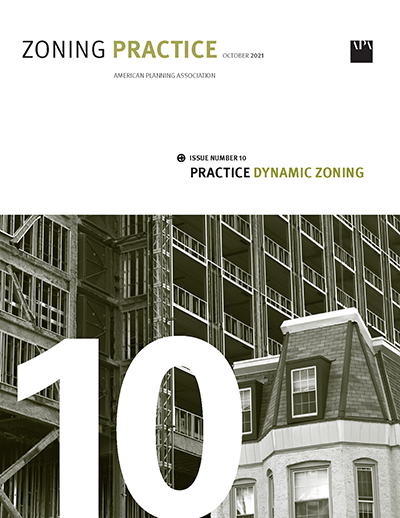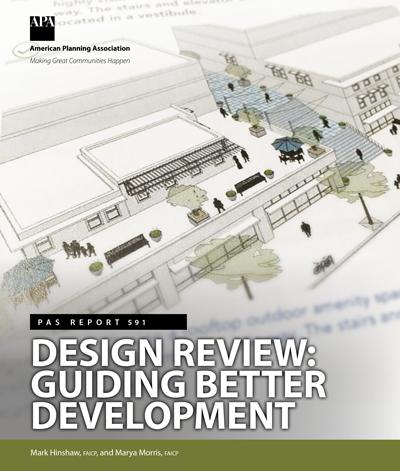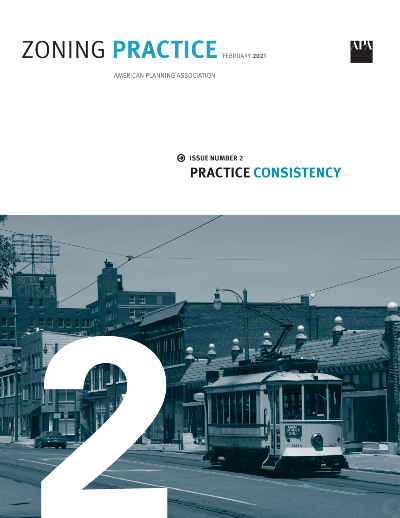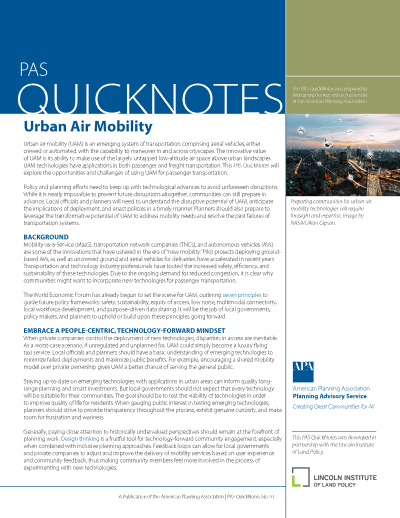Looking for education on this topic?
Check Out Our Passport Courses
Passport is your ticket to the training, experiences, and connections that will take you where you want to go in your planning career. Subscribe for unlimited access for one year to APA's extensive learning library of solution-oriented content facilitated by planners, for planners.
-
Ending Zoning’s Racist Legacy
Zoning Practice — January 2022by: Jennifer Raitt January 01, 2022This issue of Zoning Practice summarizes how exclusionary zoning practices reinforce patterns of segregation originally established by illegal racial zoning, racially restrictive covenants, and federal policies in the first half of the 20th century. And it highlights steps Boston and Louisville, Kentucky, have taken to begin to rectify these inequities through zoning reforms.List price$0.00ZP subscriber$0.00 -
Coordinating Community Growth to Promote Physical Activity
Planning Approaches to Encourage Physical Activity in Small and Rural Communitiesby: Johamary Pena, AICP, Sagar Shah, PhD, AICPThis blog post provides an overview of growth area identification as a planning approach to increase physical activity in small and rural communities through everyday destinations. It is part of the Everyday Destinations series. -
Creative Placemaking for Community Health
Planning Approaches to Encourage Physical Activity in Small and Rural Communitiesby: Johamary Pena, AICP, Sagar Shah, PhD, AICPThis blog post provides an overview of community events as a planning approach to increase physical activity in small and rural communities through everyday destinations. It is part of the Everyday Destinations series. -
Activating Communities Using Pop-Up Designs
Planning Approaches to Encourage Physical Activity in Small and Rural Communitiesby: Johamary Pena, AICP, Sagar Shah, PhD, AICPThis blog post provides an overview of pop-up designs and activations as a planning approach to increase physical activity in small and rural communities through everyday destinations. It is part of the Everyday Destinations series. -
Building on Community Assets to Encourage Physical Activity
Planning Approaches to Encourage Physical Activity in Small and Rural Communitiesby: Johamary Pena, AICP, Sagar Shah, PhD, AICPThis blog post provides an overview of elevating community assets to increase physical activity in small and rural towns. It is part of the Everyday Destinations series. -
Advancing Active Living Through Adaptive Reuse
Planning Approaches to Encourage Physical Activity in Small and Rural Communitiesby: Johamary Swena, AICP, Sagar Shah, PhD, AICPThis blog post provides an overview of adaptive reuse as a planning approach to increase physical activity in small and rural towns. It is part of the Everyday Destinations series. -
A Planner’s Guide to Meeting Facilitation
PAS Report 595by: Milton Herd, FAICP June 01, 2019Leading a public meeting can be challenging, and this responsibility often falls to planners — but meeting facilitation skills are not usually taught in schools. This PAS Report offers step-by-step guidance in planning, preparing for, and leading a group meeting to a productive outcome.List price$25.00APA member & PAS subscriber$0.00 -
What Is a Complete Community?
by: Grant Holub-MoormanUncovering JAPA: Explore 'Complete Communities' and how it evolved to emphasize positive attributes like sustainability and livability. -
Asset-Based Community Development
PAS QuickNotes 97by: Alexsandra Gomez December 01, 2021This edition of PAS QuickNotes highlights how planners can use ABCD to inform solution-oriented and conscious practices in all aspects of the planning process and advance equitable and restorative planning.Nonmember price$10.00APA members & PAS subscribers$0.00 -
Zoning Minimalism
Zoning Practice — December 2021by: Norman Wright, AICP December 01, 2021This issue of Zoning Practice makes a case for why a minimalist approach to zoning may be necessary to achieve our core aims. It proposes five simple rules that could constitute the basis of an effective zoning code and demonstrates how these rules might work in practice. -
Empowering the Next Generation of Planners
by: Dina WaltersEquity In Practice: In Boston, a collaborative effort is empowering diverse youth to pursue careers in urban planning and create positive community impact. -
Can Transit-Oriented Developments Include Affordable Development?
by: Grant Holub-MoormanUncovering JAPA: Explore hurdles to affordable housing in Southern California's transit-oriented developments, and the importance of legislative and local government support for inclusivity in transit communities. -
The Global Challenge of Planning for Housing
The housing supply crisis is an international challenge. Planners and policymakers in countries around the globe are grabbling with how to increase housing diversity, attainability, and equity. The Presidents of APA, the Royal Town Planning Institute, and the Canadian Institute of Planners will talk about what’s happening in their respective countries and how planners are rising to the challenge.- Jason Jordan
- Angela Brooks, FAICP
- Lindsey Richards
- Dan Huang
- Andrea Harris
- Darren Crombie
#9290112CM | 0.75Housing Supply Accelerator Playbook
May 06, 2024The Housing Supply Accelerator Playbook is for local elected officials and community planners working to boost diverse, attainable, and equitable housing supply in communities nationwide.Journey Toward Better Decision-Making Using Digital Twins
by: Jon DePaolisDigital twins are having a moment — becoming more and more part of the built environment zeitgeist as planners look for ways to visualize and better design their communities.Will We Zone For Transit?
by: Grant Holub-MoormanUncovering JAPA: Explore how transit-oriented development (TOD) emerged as a crucial strategy in curbing urban sprawl with the 2023 Montreal light rail project.Planning the Wildland-Urban Interface
PAS Report 594by: Molly Mowery, AICP, Anna Read, AICP, Kelly Johnston, Tareq Wafaie, AICPWildfires pose a growing threat to communities across the country as development in the wildland-urban interface (WUI) accelerates. This PAS Report offers a holistic planning framework helping planners guide land-use decisions to create communities that are safer and more resilient to wildfire.List price$0.00APA member & PAS subscriber$0.00Planning for Dementia-Friendly Communities
PAS Memo — November-December 2021by: Jonathan KatzThis PAS Memo identifies strategies to engage people with dementia in planning processes and incorporate dementia-friendly approaches in planning for transportation, housing, public space, urban fabric, and social services.Nonmember price$10.00APA members & PAS subscribers$0.00Dynamic Zoning
Zoning Practice — October 2021by: Patrick Braga October 01, 2021This issue of Zoning Practice explains the need for and fundamental characteristics of dynamic land-use and development regulations. It surveys historical and contemporary precedents and summarizes three approaches communities can use to implement dynamic zoning.List price$10.00ZP subscriber$0.00Planning With Diverse Communities
PAS Report 593by: Ivis Garcia, AICP, Andrea Garfinkel-Castro, Deirdre Pfeiffer, AICP January 01, 2019The U.S. will become a “majority-minority” country by the mid-2040s. More than before, planners must serve diverse publics and build inclusive communities. This PAS Report offers the tools planners need to engage people of color and improve quality of life for all in ethnically and racially diverse communities.List price$25.00APA member & PAS subscriber$0.00Protecting Vulnerable Populations from Flood Hazards
Zoning Practice — September 2021by: Thomas SmithThis issue of Zoning Practice focuses on risk assessment, mitigation, and zoning recommendations for hospitals, nursing homes, and assisted living facilities. It explores how Boulder, Colorado; New York City; and several cities and counties in Florida have updated their land-use and development codes to protect vulnerable populations from coastal storms and flooding.List price$10.00ZP subscriber$0.00Design Thinking in Planning Practice
PAS Memo — September-October 2021by: Thomas Fisher September 01, 2021This PAS Memo explains design thinking and explores how this process can bring creativity, agility, and inclusion to planning practice, offering communities an effective set of tools to achieve their goals.Nonmember price$10.00APA members & PAS subscribers$0.002022 Trend Report for Planners
by: Petra Hurtado, PhD, Sagar Shah, PhD, , Joseph DeAngelis, AICP, Alexsandra Gomez January 18, 2022The 2022 Trend Report for Planners features nearly 100 existing, emerging, and potential future trends that APA identified as relevant to planning. The trends are structured within three timeframes (Act Now, Prepare, Learn and Watch), which indicate the urgency of planners’ action.Climate-Resilient Pollinator Gardens
PAS QuickNotes 96by: Sagar Shah, PhD, AICPThis edition of PAS QuickNotes explains how planners can use pollinator gardens with native plants to enhance their communities, increase climate resiliency by reducing extreme heat and flooding risks, and achieve the GI goals of protecting natural ecosystems and conserving biodiversity.Nonmember price$0.00APA members & PAS subscribers$0.00Urban Heat Resilience
PAS QuickNotes 95by: Ladd Keith, Sara MeerowThis edition of PAS QuickNotes explains national trends in extreme heat and describes how planners can enhance urban heat resilience for their communities through planning and implementing heat mitigation and management strategies.Nonmember price$10.00APA members & PAS subscribers$0.00Smarter Zoning by Street and by Block
Zoning Practice — August 2021by: John Myers August 01, 2021This issue of Zoning Practice proposes a new, ultralocal, approach to upzoning that would use resident-initiated upzonings to increase housing supply and diversity on a street-by-street or block-by-block basis.List price$10.00ZP subscriber$0.00Planning Officials Training Program
Planning Officials are often appointed with little to no background in community planning. Once appointed, there generally is little time and limited resources to secure the training needed to help them make sound decisions for their communities. APA's Planning Officials Training Program gives planners the tools and resources to effectively and easily on-board and train planning officials.December 20, 2021, 12:00 a.m. to January 25, 2024, 12:00 a.m. CST- Linda Amato, FAICP
- Ann Bagley, FAICP
- Michael Blue, FAICP
- Bonnie Johnson, FAICP, PhD
- Gregory Jones, AICP
- Stan Popovich, AICP
- Marjorie Press
- David Silverman, FAICP
#9227447Long Beach’s Approach to Youth Advocacy in Planning
by: Isabella TiceUncovering JAPA: Long Beach invests in Youth, establishing a Global Model with the Office of Youth Development.Guiding Plan Implementation With Degree of Change
PAS Memo — July-August 2021by: John Zeanah, AICPThis edition of PAS Memo explores how the city of Memphis used the Degree of Change approach to guide plan implementation and community reinvestment by targeting appropriate actions to designated Accelerate, Sustain, and Nurture areas of the city.Nonmember price$10.00APA members & PAS subscribers$0.00Planning With Foresight
PAS QuickNotes 94by: Petra Hurtado, PhDThis edition of PAS QuickNotes introduces the concept of foresight to help planners imagine and prepare their communities for the future.Nonmember price$0.00APA members & PAS subscribers$0.002024 Trend Report for Planners
by: Petra Hurtado, PhD, Sagar Shah, PhD, AICP, Joseph DeAngelis, AICP, Ievgeniia Dulko, Senna Catenacci, Scarlet Andrzejczak January 31, 2024The 2024 Trend Report features a list of over 100 existing, emerging, and potential future trends that the APA Foresight team, together with our Trend Scouting Foresight Community, identified as relevant to planning.Planning for Autonomous Mobility
PAS Report 592by: Jeremy Crute, William Riggs, AICP, Timothy Chapin, Lindsay Stevens, AICP September 01, 2018Autonomous vehicles are poised to disrupt the built environment and planning practices. This PAS Report offers a road map for planners as they develop policy solutions and infrastructure investments for the future of AVs.List price$25.00APA member & PAS subscriber$0.00Refocus Heat Action Plans To Mitigate Indoor Heat Risks
by: Felix RosenUncovering JAPA: Study finds the importance of prioritizing building improvements over tree planting strategies for mitigating the risk of indoor extreme heat.Advancing Racial Equity Through Land-Use Planning
PAS Memo — May-June 2021by: Paul Mogush, AICPThis edition of PAS Memo explains how the city of Minneapolis addressed racial equity issues in their comprehensive planning process and became the first major U.S. city to eliminate single-family zoning.Nonmember price$10.00APA members & PAS subscribers$0.00Design Review: Guiding Better Development
PAS Report 591by: Mark Hinshaw, FAICP, Marya Morris, FAICP July 01, 2018Get an update on the time-tested tool of design review and guidance on creating effective design review processes, standards, and guidelines to improve development in local communities.List price$25.00APA member & PAS subscriber$0.00Boston Takes on Climate Change
Among the world's most prepared but also the most vulnerable, the city is making big plans to protect itself.by: Anthony Flint April 21, 2021Planners, engineers, and others in Boston have been working for years to prepare for the inevitable impacts of climate change – a projected 40 inches of sea level rise, and the creeping storm surge and high-tide flooding that comes with it.Prioritizing Environmental Justice in Comprehensive Planning
by: Adin BeckerUncovering JAPA: California plans are analyzed for environmental justice (EJ) incorporation, revealing advancements in BIPOC communities while underscoring the absence of an explicit racial focus.The Continuing Evolution of Complete Streets
by: Lisa Nisenson, Andrew Crozier, AICP, Eunice Read, AICPDecember 2023 marks the 20th anniversary of the first official use of the term "Complete Streets," learn about key trends and influencing factors that will continue to shape the Complete Streets of the future.Zoning, Land Use, and Local Policies for Environmental Justice
Zoning Practice — March 2021by: Ana BaptistaThis issue of Zoning Practice reviews the relationships among zoning, land use, and environmental justice. It highlights local strategies that illustrate the diversity of approaches cities and counties across the country are using to protect traditionally overburdened areas from noxious land uses.List price$10.00ZP subscriber$0.00Partnering with Health Systems on Affordable Housing Investments
PAS Memo — March-April 2021by: Alyia Gaskins March 01, 2021The March/April 2021 edition of PAS Memo explains why and how planners can partner with hospitals and health systems to create more equitable communities through affordable housing development.Nonmember price$0.00APA members & PAS subscribers$0.00Reconsidering the Role of Consistency in Plan Implementation
Zoning Practice — February 2021by: John Zeanah, AICP February 01, 2021This issue of Zoning Practice considers how consistency is used in plan implementation to align zoning regulations and land use decisions with local plans. It makes recommendations based on examples from across the United States for how planners and municipalities can build consistency by building stronger links between local codes, regulatory mechanisms, and existing local planning processes.List price$10.00ZP subscriber$0.00Urban Air Mobility
PAS QuickNotes 91by: Alexsandra Gomez February 01, 2021This edition of PAS QuickNotes explores the opportunities and challenges of using urban air mobility (UAM) — aerial vehicles, either crewed or automated, with the capability to maneuver in and across cityscapes — for passenger transportation.Nonmember price$0.00APA members & PAS subscribers$0.00Local Food Systems Key to Healthy, Resilient, Equitable Communities
From the economy and environment to health and food access, local and regional food systems can help address a wide range of community concerns.by: Mary Hammon, Cynthia Currie February 01, 2021As pressures on the U.S. agriculture and food businesses grow, governments across the country are experimenting with local and regional food systems models to better need their communities' needs.New Challenges for Old Problems: Housing Affordability in a Comparative Perspective
The course will explore new ways to address old problems regarding lack of housing.- Bishwapriya Sanyal
- Salvador Herrera
- NICOLAS MAGGIO
- Agustina Biasone
- Carina Arvizu Machado
- Tenzin Jamtsho
- Jing Zhang, AICP
#9283593CM | 1Illinois Solar Model Ordinance
August 2020This model ordinance provides a template to help planners in Illinois draft land-use and development regulations that permit solar development at different scales and in different land-use contexts.Iowa Solar Model Ordinance
August 2020This model ordinance provides a template to help planners in Iowa draft land-use and development regulations that permit solar development at different scales and in different land-use contexts.Wisconsin Solar Model Ordinance
August 2020This model ordinance provides a template to help planners in Wisconsin draft land-use and development regulations that permit solar development at different scales and in different land-use contexts.Minnesota Solar Model Ordinance
August 2020This model ordinance provides a template to help planners in Minnesota draft land-use and development regulations that permit solar development at different scales and in different land-use contexts.Kentucky Model Solar Zoning Ordinance
September 2020This model ordinance provides a template to help planners in Kentucky draft land-use and development regulations that permit solar development at different scales and in different land-use contexts.New York Solar Guidebook for Local Governments
August 2020This guide includes several tools and resources to support municipalities with the development, installation, and maintenance of solar energy projects.



